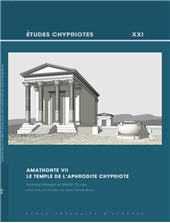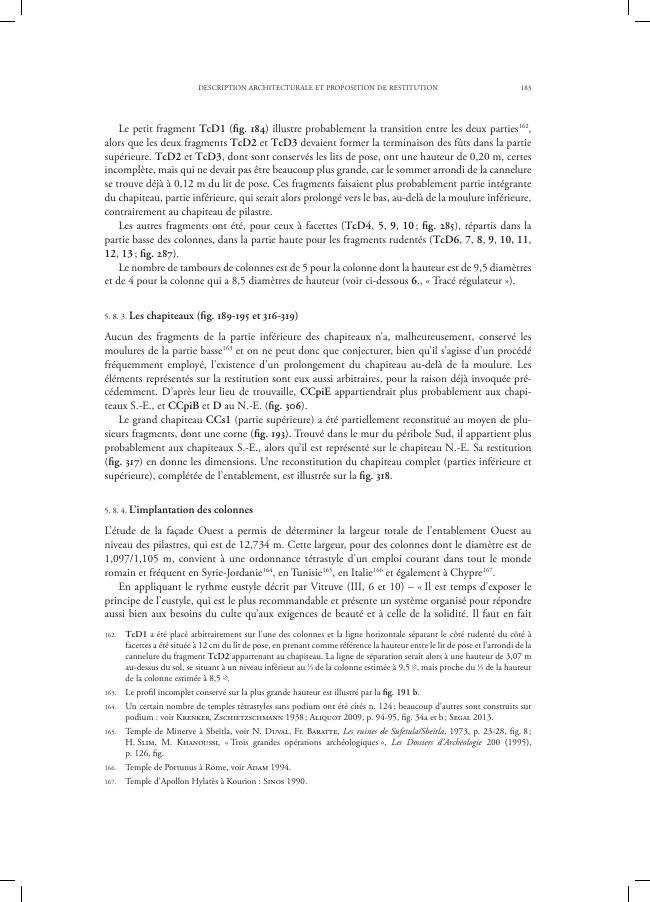2021 - École française d'Athènes
E-book
Digital Version
Download | Copy/paste | Printing
Amathonte VII : le temple de l'Aphrodite chypriote
354 p. : ill. (some col.).
- Ce volume consacré au temple de l'Aphrodite Chypriote, construit vers la fin du Ier s. apr. J.-C., fait suite à celui qui a été publié en 2006 par S. Fourrier et A. Hermary sous le titre Le sanctuaire d'Aphrodite, des origines au début de l'époque impériale (Amathonte VI, études chypriotes XVII). Les sculptures et les figurines en terre cuite avaient été précédemment étudiées par A. Hermary dans le volume Amathonte V (études chypriotes XV, 2000 ; voir aussi A. Queyrel dans Amathonte IV, 1988). Le temple a été presque entièrement détruit autour de 600 apr. J.-C. et ses pierres ont été en grande partie réutilisées pour la construction d'une petite basilique chrétienne.
- L'étude des nombreux blocs trouvés au cours d'une quinzaine de campagnes de fouilles et la restitution graphique et numérique du bâtiment ont constitué un enjeu majeur de la mission de l'EFA et du MAE à Amathonte, avec le support du Département des Antiquités de Chypre qui, dans un premier temps, avait entrepris de compléter les parties manquantes de la crépis du monument. L'étude a permis de restituer l'essentiel de la structure architecturale de ce temple tétrastyle, caractérisée par ses chapiteaux "nabatéens" étrangers à la tradition grecque qui, avec les colonnes et les pilastres qui les portent, animent les façades plutôt austères. Elle révèle aussi le rôle primordial que tenait à l'époque impériale le sanctuaire d'Amathonte, le plus important lieu de culte chypriote de la déesse après celui de l'Ancienne-Paphos [Résumé par l'éditeur].
- This volume focuses on the temple of the "Cyprian Aphrodite", built in the late 1st century AD, following the 2006 publication by S. Fourrier and A. Hermary Le sanctuaire d'Aphrodite, des origines au début de l'époque impériale (Amathonte VI, études chypriotes XVII). The stone sculptures and the terracottas were previously studied by A. Hermary in the volume Amathonte V (études chypriotes XV, 2000; see also A. Queyrel in Amathonte IV, 1988). The temple was almost completely destroyed around AD 600 and many of its stones were reused for the construction of a small Christian basilica. The study of the numerous blocks found during fifteen excavation campaigns as well as the graphic and digital reconstruction of the building were a major purpose of the French mission at Amathus, a common program of the French School at Athens and the French Ministry of Foreign Affairs.
- The mission was supported by the Department of Antiquities of Cyprus, who initially undertook the reconstruction of the missing parts of the crepis of the monument. This study allows us to restore the main parts of the architectural structure of this tetrastyle temple, characterized by its "Nabataean" capitals, foreign to the Greek tradition which, with the columns and pilasters that support them, enliven the rather austere facades. It also reveals the primordial role played in imperial times by the sanctuary of Amathus, the most important Cypriot cult place of the goddess after her famous sanctuary of Old Paphos [Publisher's text].
-
Information
ISBN: 9782869584631
SERIES



